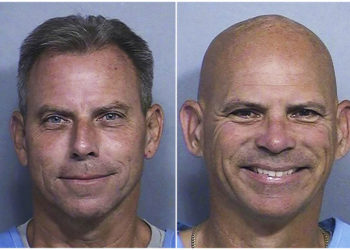Gov. Kathy Hochul traveled to the territory of the largest Native tribe in New York State Tuesday to apologize for the atrocities committed at the long-closed Thomas Indian School, where Native children were systematically stripped of their culture and language and subjected to abuse.
The school opened in 1855 on Seneca Nation territory as the Thomas Asylum for Orphan and Destitute Indian Children, and, unlike the many federally operated boarding schools that housed Native American children, it was overseen by state authorities.
“But instead of being a haven for orphaned children, it became a place of nightmares, a place some would call a torture chamber,” Ms. Hochul said. “A site of sanctioned ethnic cleansing.”
A federal reckoning of the legacy of these boarding schools for Native American children began a few years ago, and led to an apology from then-President Biden last year. But the trauma inflicted by New York State at the Thomas Indian School, which took a strikingly similar approach to the forced assimilation of Native children in schools run by the U.S. government, has largely remained in the shadows.
On Tuesday morning, Ms. Hochul’s appearance on the Seneca Nation’s Cattaraugus Territory, about an hour south of Buffalo, thrust the school’s history into the spotlight.
Ms. Hochul met with over a dozen members of the Seneca Nation, some now using canes and wheelchairs, who attended the school, which shut down in 1957. All around them were reminders of the ordeals faced by many of the 2,500 Native children who were sent to the school during more than a century of operation.
They gathered in a building that sits on land once used by the school, situated next to its old red brick infirmary, repurposed as the Seneca Nation Tribal Courts Building.
After her private meetings, Ms. Hochul walked past a row of placards describing the involuntary family separations, hard labor and physical and sexual abuse that occurred at the school. One of the placards featured an oversized copy of an 1892 article in The Buffalo Enquirer, under the headline, “Simply Awful. Poor Indian Orphan Girls Beaten, Starved and Horribly Ill-Treated.”
As Ms. Hochul met with the Thomas Indian School survivors, a crowd of Senecas awaited her speech outside, where tribal members in traditional regalia opened the public portion of the ceremony with a prayer in the Seneca language and ancient dances.
The Seneca Nation president, J.C. Seneca, whose father attended the Thomas Indian School, welcomed Ms. Hochul to the “sacred ground” where he said some of the souls of those who suffered at the school still wander.
Then the governor stepped up to the microphone and delivered a formal apology that Seneca leaders said they never thought they’d hear. “On behalf of the State of New York, I, Governor Kathy Hochul, apologize to the Seneca Nation of Indians and survivors and descendants from all nations who attended the Thomas Indian School.”
The governor acknowledged the gesture was “long overdue” but called it a first step toward healing and better relations with the tribe.
“I cannot change the horrors of the past,” she said. “I wish I could just wipe it all away.”
Presbyterian missionaries founded the institution in 1855 after a typhoid outbreak left dozens of children orphaned and destitute, according to a historical account of the school published in Judicial Notice, a journal specializing in New York legal history.
Many survivors and their descendants still refer to the school as “Salem,” a mispronunciation of the word asylum. Though it was a private institution, the New York Legislature appropriated money for the construction of the facility and provided annual funding, while officials in Albany oversaw the instruction. New York State finally took it over in 1875 and eventually renamed it the Thomas Indian School.
In 1892 scandal first struck the school when allegations of sexual abuse surfaced about the superintendent, John H. Van Valkenburg, “ranging from illicit relations with young female residents to mishandling of the institution’s finances,” according to the Judicial Notice article.
Mr. Van Valkenburg, whose efforts to rid the Native children of their “inherited shiftlessness” included forced labor outside the school, escaped criminal punishment after a court ruled he was “insane,” Lori Quigley, the author of the article, said.
Some welcomed Ms. Hochul’s visit, said to be the first by a sitting New York governor to the Seneca Nation’s traditional territories.
“It’s about time that someone acknowledged the harm that New York State has done over the generations to our people,” said Dianna Beaver, a septuagenarian whose grandmother attended the Thomas Indian School.
But others say the overdue apology was not enough to counter what they perceive as hostile treatment from the governor. Three years ago, Ms. Hochul froze the Nation’s bank accounts as a way to force payment of $564 million in gambling revenues from its casinos, a move that she characterized as “playing hardball” to resolve a longstanding dispute.
She then directed $418 million of that money toward the financing of a new home for the Buffalo Bills. The tribe contends it never owed the money, though federal courts backed the state’s demands.
And Ms. Hochul and the tribe have yet to forge a renewal of the Seneca casino compact, whose current arrangement of 25 percent revenue share for the state and weak protections from competitors make it one of the worst arrangements for Native tribes in the United States. The two sides have been at a stalemate over a renewal since the compact expired about 18 months ago.
Elliott Tallchief, 85, who recalled having his mouth washed out with soap for speaking his Native language at the school in the 1940s, said the atonement should have come sooner.
“They should have started a long time ago,” he said. “My healing hasn’t started yet. Here I am in my 80s. So where does my healing begin?”
Mr. Seneca, who was elected president of the tribe in November, was more diplomatic. He had urged the governor to make a formal apology during a meeting with her in Albany several weeks ago, and said that Ms. Hochul had “compassion” for the Senecas and called her visit a step toward making progress on “the bigger issues that we face.”
Ms. Quigley, an enrolled Seneca member and Niagara University professor, said the damage from the Thomas Indian School has reverberated through the generations, contributing to depression, alcoholism and other ills. Her own aunt was sexually abused at the school and her mother “was never shown love” — only hatred and disdain, she said.
“I don’t believe in an apology, and a lot of the survivors that I’ve interviewed in my research over the years have said the same thing,” she said. “I think what people over the years have looked for more than anything was a simple acknowledgment that this school existed, that terrible atrocities were done to the children who lived there.”
Jay Root is an investigative reporter based in Albany, N.Y., covering the people and events influencing — and influenced by — state and local government.
The post Hochul Apologizes to Native Americans for Boarding School Atrocities appeared first on New York Times.




